Meet the 2022 Laboratory Fellows
Only 3% of PNNL researchers hold the rank of Laboratory fellow
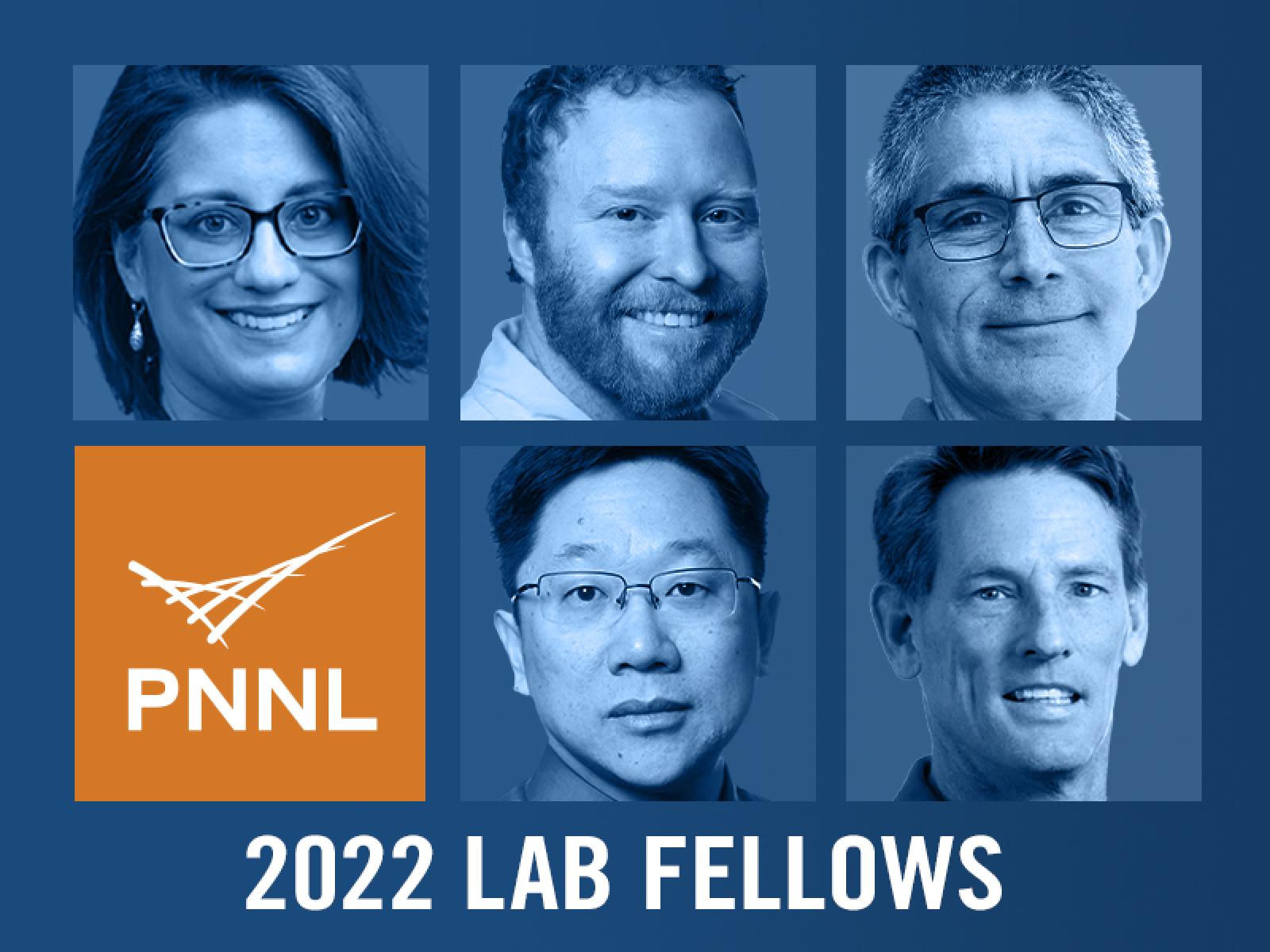
Vanessa Bailey, David Heldebrant, Greg Kimmel, Wei Wang, and David Wunschel
(Composite image by Kelly Machart | Pacific Northwest National Laboratory)
Laboratory fellows are Pacific Northwest National Laboratory (PNNL) researchers who have built a reputation of using their creativity, expertise, and leadership to move the needle forward in their respective fields. Each year, PNNL Director Steven Ashby selects new fellows through recommendations from a review committee of other Laboratory fellows. Fellows serve as advisors and are relied upon to help the laboratory break through technical barriers to achieve audacious goals in support of sponsor priorities.
See the complete list of Laboratory fellows.
We interviewed the new Laboratory fellows—Vanessa Bailey, David Heldebrant, Greg Kimmel, David Wunschel, and Wei Wang to learn about their contributions to their field, what drives them, and how their research is making the nation safer, greener, and more resilient.
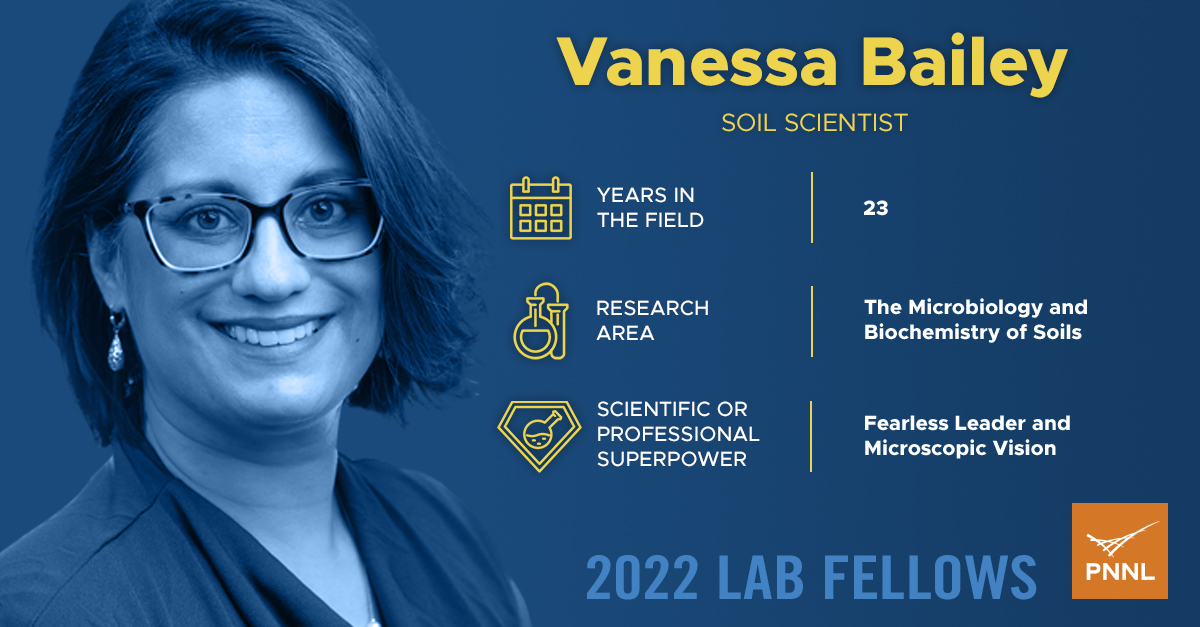
Vanessa Bailey has a distinguished record of scientific accomplishments in soil science, biogeochemistry, and environmental microbiology. Her research is focused on gaining insight on microbial communities in soil, which is crucial for understanding land-use effects on ecosystems and the impact of climate change. Bailey has over 23 years of experience in her field as a soil scientist, and previously served as the chair for the Soil Biology and Biochemistry Division of the Soil Science Society of America from 2019-2022.
Where did you grow up and was there one experience that sparked your interest in science?
“I grew up in Brandon, Manitoba, Canada, where farming and agriculture are central to the lifestyle and economy. I’m a second-generation soil scientist and I knew I wanted to become a scientist when my dad described his job as asking questions for a living.”
What should the public know about your research and how it impacts their lives?
“Soil is very much the foundation of a healthy society. Healthy soil contributes to a safe, reliable food supply, but it’s also an important element of global climate change. The goal of my research is to develop an understanding of how soil microbes, soil nutrients, and water interact to regulate greenhouse gas emissions. I work at a very fine scale, where microbes function, but their activities change in response to large events such as tides, floods, and droughts. Similarly, their feedback to climate change through greenhouse gas emissions affect these large, regional processes.”
What does a day in the life look like for you?
“In a given day, I spend a lot of time collaborating with a team of scientists who are working towards a common goal. Some days we’re out in the field studying ecosystems in place, or back at the lab trying new approaches and techniques, or attending meetings.”
What would you consider your single greatest professional accomplishment or scientific breakthrough?
“I am particularly proud of the work my team did to develop an approach to measure and understand chemical and biological processes at very fine scales, like pores or soil aggregates, that have never before been measured.”
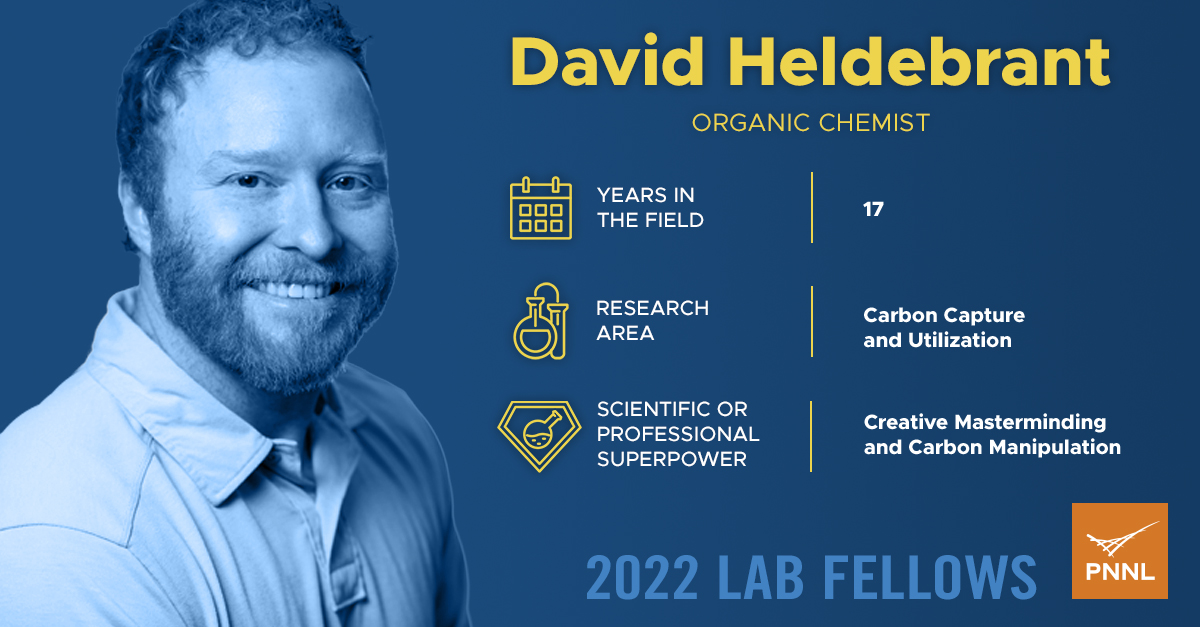
David Heldebrant has advanced a fundamental understanding of solvent-based carbon dioxide capture by identifying the relation between the molecular structure of organic liquids and their macroscopic properties. This led to the development of pilot scale systems that exceeded Department of Energy (DOE) goals for carbon capture technology. Heldebrant has over 17 years of experience at PNNL and was recently named a Fellow of the American Chemical Society.
Where did you grow up and was there one experience that sparked your interest in science?
“I grew up in Arcadia, California, and my love of science was instilled in me by my family of nerds. My father has a PhD in biochemistry, and my older brother has a PhD in Pharmacology, so it was natural for me to follow in their footsteps.”
What should the public know about your research and how it impacts their lives?
“The work that I do is “Green Chemistry,” with the aim of making chemical processes such as power production or separations more environmentally friendly and efficient.”
What does a day in the life look like for you?
“My team kindly banned me from the laboratory, so I spend most of my day communicating the progress, results, and impact of our research at program briefings. I also do a lot of writing-whether that’s reports, scientific publications, or proposals—to share our research with the larger scientific community and the public.”
What would you consider your single greatest professional accomplishment or scientific breakthrough?
“I’d like to think that my greatest accomplishment at PNNL has been helping grow our portfolio and team from a few chemists on Laboratory-Directed Research and Development (LDRD) to a multidisciplinary team of 25 highly talented staff stewarding one of DOE’s flagship programs in carbon capture. I believe that my biggest breakthrough was not to be afraid of challenging conventional thinking and taking risks that nobody else had the courage to do.”
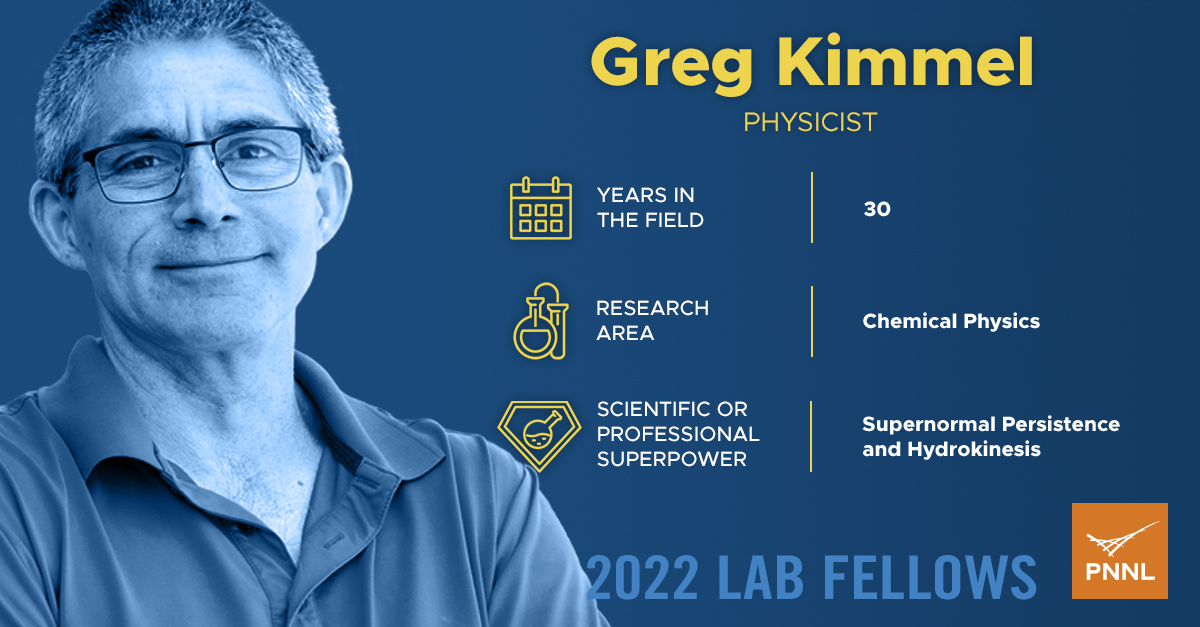
Greg Kimmel is known for his creativity to design innovative experiments to investigate non-thermal reactions in water, the structure of water at interfaces, and the structure and reactivity of adsorbates on metal oxides. His experiments on supercooled water provide data in a previously inaccessible temperature range that is key to understanding water’s anomalous properties. Kimmel has over 30 years of experience in his field as a physicist and considers being a recipient of the Laboratory Director’s Award for Exceptional Scientific Achievement in 2021 as one of his greatest recognitions.
Where did you grow up and was there one experience that sparked your interest in science?
“I grew up in a small town, Brocton, NY which is about 60 miles south of Buffalo, NY. My desire to pursue a degree in physics increased when I took an honors physics lab class my sophomore year in college. The physics department had a collection of old, early to mid-20th century instruments in the attic of one of the physics buildings. For this class, I was able to choose a few instruments to work on for the semester. I was really fascinated by learning how these old instruments were constructed and functioned.”
What should the public know about your research and how it impacts their lives?
“For my entire career, I’ve worked on some fundamental problems in chemical physics whose solution will not have a direct impact on peoples’ lives. However, a detailed understanding these problems can impact a wide variety of more applied problems, often in unforeseen ways. For example, the structure and reactivity of water and aqueous solutions at surfaces impacts many areas of science and technology. Investigating the properties water films on clean, well-characterized surfaces, which I have done, provides the foundation for understanding more complicated “real world” situations.”
What does a day in the life look like for you?
“I love when I get to think about some puzzling aspect of an experiment. The most rewarding part of my work is discussing with my colleagues possible explanations for the observations we find while conducting the experiments we use to test ideas. Science also involves a lot of processes and teamwork, so on most days you’ll catch me working on the more mundane aspects of running a research program, like meeting with collaborators and writing reports.”
What would you consider your single greatest professional accomplishment or scientific breakthrough?
“I developed an experimental technique that allows us to make measurements on deeply supercooled water in a temperature range that had been previously inaccessible due to rapid crystallization. The results of experiments with this technique have resolved some long-standing questions about the properties of water.”
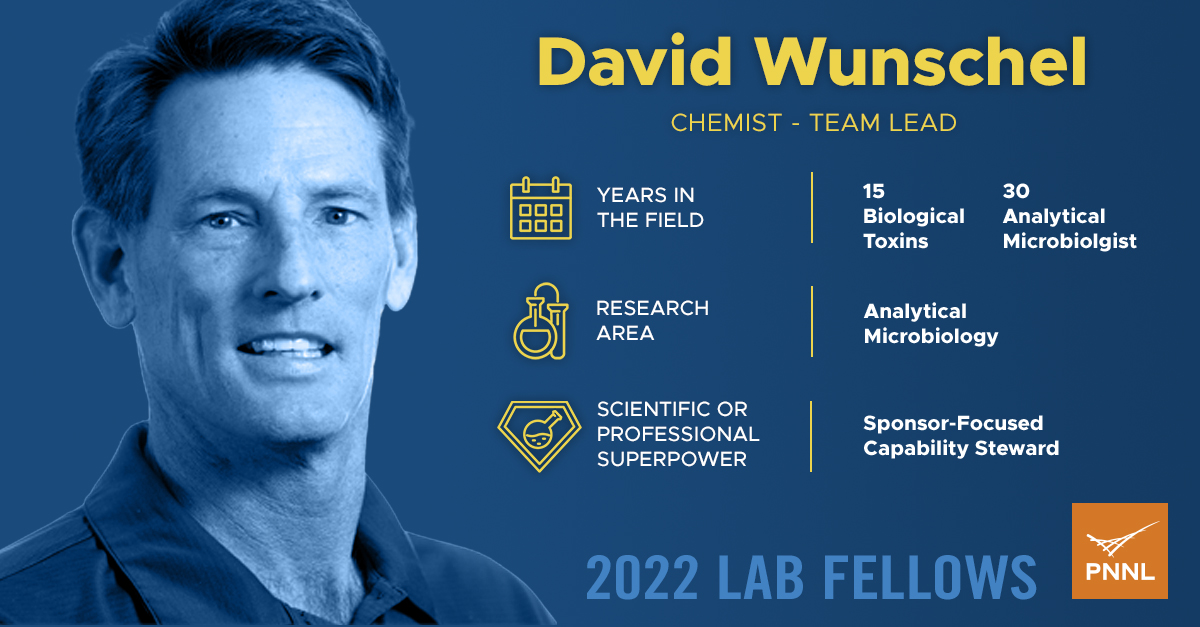
David Wunschel has established PNNL as the premier laboratory for toxin detection, characterization, and forensics for the national security community. This was achieved by developing capabilities and cross-disciplinary teams that apply mass spectrometry and data analytic methods to biomolecule analysis. Wunschel, who has nearly 30 years’ experience as a chemist, credits “continued faith and trust from our sponsors” as being the best and most important measure of his work.
Where did you grow up and was there one experience that sparked your interest in science?
“I grew up in Carroll, a very small town in Western Iowa. I didn’t have one experience that sparked my interest in science but rather I always had a sustained curiosity in figuring out how things work in living systems.”
What should the public know about your research and how it impacts their lives?
“My team supports the United States Government national security community in solving some of their hardest questions in bioforensics, which is the science of determining the source of a biological agent. We’ve done this by providing a combination of subject matter expertise and laboratory method development for our sponsors.”
What does a day in the life look like for you?
“These days I am mostly focused on technical project management and ensuring that each of our research projects continue to meet sponsor objectives.”
What would you consider your single greatest professional accomplishment or scientific breakthrough?
“Being part of the team that recognized the utility of protein and metabolite identification methods for answering specific forensic questions about biological agents and their related materials for the national security community. The sustained growth in staff and projects to refine, improve and expand our portfolio of capabilities demonstrates the impact that our work has had for the sponsor community.”
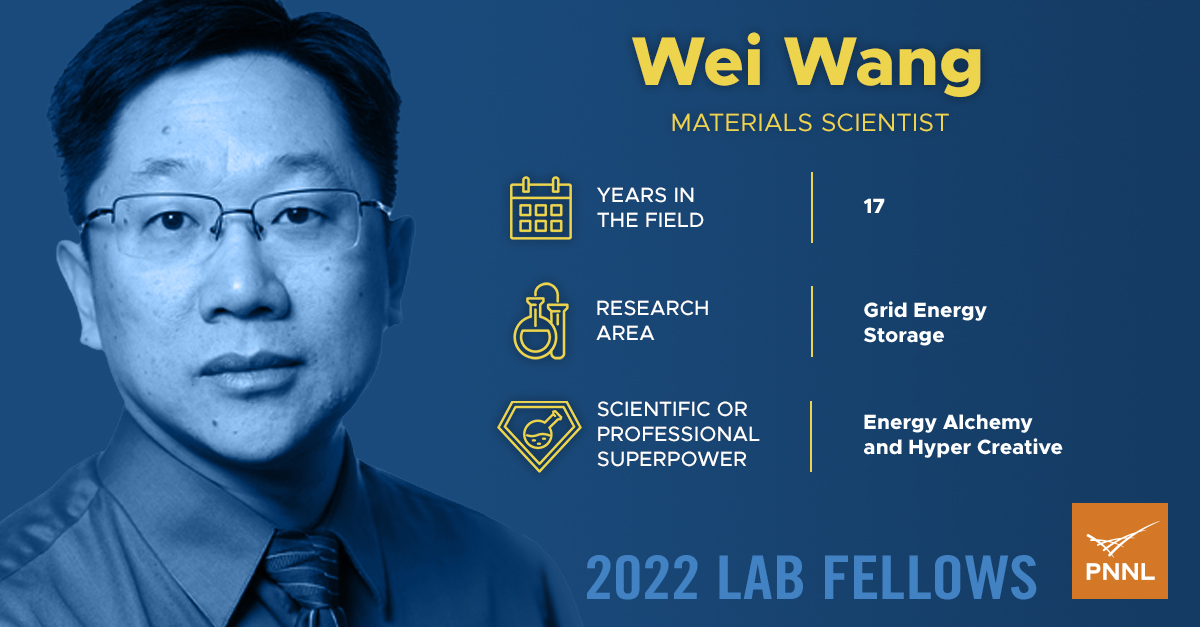
Wei Wang, has revolutionized the development of highly concentrated aqueous electrolytes for redox flow batteries used in grid-scale energy storage. His study of fundamental electrolyte solvation structure and redox mechanism has led to advanced high energy density electrolytes and enabled electrochemical reversibility from natively redox-inactive molecules.
Wang, a materials scientist, credits being awarded as one of Clarivate Analytics’ 1% Highly Cited Researcher in 2018 to be one of his greatest achievements.
Where did you grow up and was there one experience that sparked your interest in science?
“I grew up in Yibin in southwest China's Sichuan Province, located at the confluence of the Jinsha and Minjiang rivers, which converge into the Yangtze River. Yibin is known as the "first city along the Yangtze River." My father is a middle school chemistry teacher. He showed me a calcium carbonate precipitation experiment by breathing into the lime water when I was probably five or six years old.”
What should the public know about your research and how it impacts their lives?
“My research is focused on developing grid energy storage technologies, a critical part of the future zero-carbon electric grid. Those systems are essential to support reducing carbon emission, renewable energy integration, a greener home and lifestyle, and widespread adoption of electric vehicles.”
What does a day in the life look like for you?
“I read a lot about new scientific breakthroughs and methods. Each bit of knowledge helps us become one step closer to realizing the vision for a powerful, stable, and reliable energy storage battery. I also meet with my team regularly, and like most of my peers, I share our findings and milestones in the form of presentations, reports, and publications”
What would you consider your single greatest professional accomplishment of scientific breakthrough?
“I am very excited that we could turn a natively redox inactive material into an active one. This has never been done before, and this material is traditionally considered impossible for battery use. This development opened the door to a new field for a class of materials.”
Published: August 19, 2022